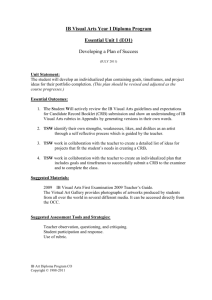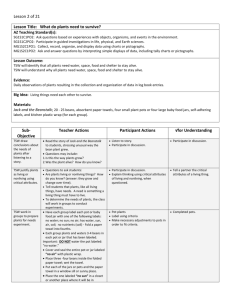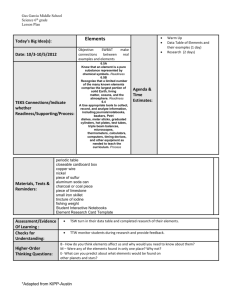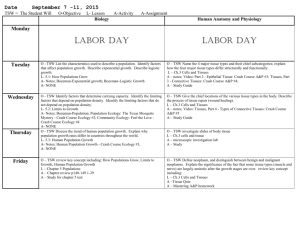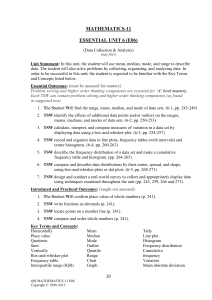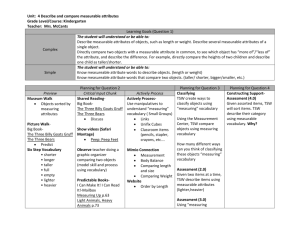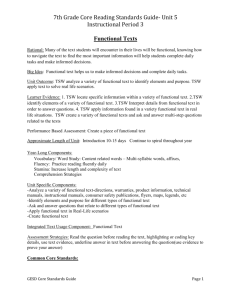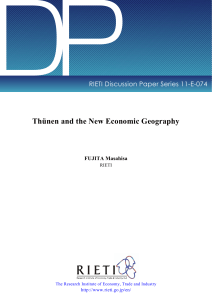AP HUMAN GEOG-E06
advertisement
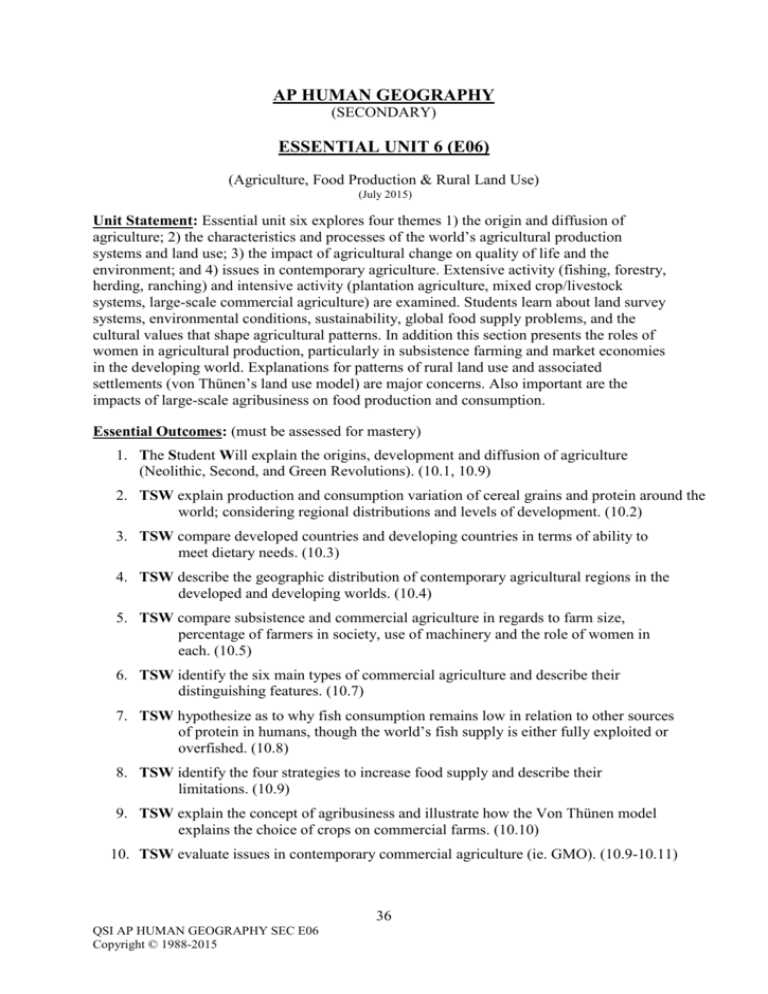
AP HUMAN GEOGRAPHY (SECONDARY) ESSENTIAL UNIT 6 (E06) (Agriculture, Food Production & Rural Land Use) (July 2015) Unit Statement: Essential unit six explores four themes 1) the origin and diffusion of agriculture; 2) the characteristics and processes of the world’s agricultural production systems and land use; 3) the impact of agricultural change on quality of life and the environment; and 4) issues in contemporary agriculture. Extensive activity (fishing, forestry, herding, ranching) and intensive activity (plantation agriculture, mixed crop/livestock systems, large-scale commercial agriculture) are examined. Students learn about land survey systems, environmental conditions, sustainability, global food supply problems, and the cultural values that shape agricultural patterns. In addition this section presents the roles of women in agricultural production, particularly in subsistence farming and market economies in the developing world. Explanations for patterns of rural land use and associated settlements (von Thünen’s land use model) are major concerns. Also important are the impacts of large-scale agribusiness on food production and consumption. Essential Outcomes: (must be assessed for mastery) 1. The Student Will explain the origins, development and diffusion of agriculture (Neolithic, Second, and Green Revolutions). (10.1, 10.9) 2. TSW explain production and consumption variation of cereal grains and protein around the world; considering regional distributions and levels of development. (10.2) 3. TSW compare developed countries and developing countries in terms of ability to meet dietary needs. (10.3) 4. TSW describe the geographic distribution of contemporary agricultural regions in the developed and developing worlds. (10.4) 5. TSW compare subsistence and commercial agriculture in regards to farm size, percentage of farmers in society, use of machinery and the role of women in each. (10.5) 6. TSW identify the six main types of commercial agriculture and describe their distinguishing features. (10.7) 7. TSW hypothesize as to why fish consumption remains low in relation to other sources of protein in humans, though the world’s fish supply is either fully exploited or overfished. (10.8) 8. TSW identify the four strategies to increase food supply and describe their limitations. (10.9) 9. TSW explain the concept of agribusiness and illustrate how the Von Thünen model explains the choice of crops on commercial farms. (10.10) 10. TSW evaluate issues in contemporary commercial agriculture (ie. GMO). (10.9-10.11) 36 QSI AP HUMAN GEOGRAPHY SEC E06 Copyright © 1988-2015 Practiced/Ongoing Outcomes: (not formally assessed) 1. The Student Will interpret maps and analyze geospatial data. 2. TSW understand and explain the implications of associations and networks in places. 3. TSW recognize and interpret the relationships among patterns and processes at different scales of analysis. 4. TSW define regions and evaluate the regionalization process. 5. TSW characterize and analyze changing interconnections among places. Key Terms and Concepts: (also look at Ch.10 glossary) Adaptive strategies Agraian Agribusiness Agr. location model Agricultural Revolution(s) Collective farm Commercial agriculture [intensive, extensive] Core/ periphery Rural settlement [dispersed, nucleated, building material, village form] Debt-for nature swap Extractive industry Farm crisis Feedlot Globalized agriculture Economic activity [primary, secondary, tertiary, quaternary, quinary] Market gardening Mineral fuels Planned economy Renewable/nonrene wable Environmental modification [pesticides, soil erosion, desertification Sustainable yield “Tragedy of the commons” Transhumance Truck farm Livestock ranching Survey patterns Suitcase farm Intertillage Extensive subsistence agriculture [shifting cultivation (slash-andburn, milpa, swidden), nomadic herding/ pastoralism Aquaculture Biorevolution Bio-technology Sauer, Carl O. Intensive subsistence agriculture Von Thunen, Johann Crop Rotation Green Revolution 37 QSI AP HUMAN GEOGRAPHY SEC E06 Copyright © 1988-2015 Suggested Materials/Resources: Rubenstein, Chapter 10: “Food and Agriculture” Kuby, Harner, and Gober, Chapter 8: “Food for Thought: The Globalization of Agriculture” Pearson’s Human Geography video series, “Sowing Seeds of Hunger” and “The Coffee-Go-Round” Pearson Online Support via www.MasteringGeography.com Technology Links: WebPath Express (found in school library) Aquaculture: http://www.fishfarming.com/ Von Thünen’s Model: http://geography.about.com/ Von Thünen’s Regional Land Use Model http://people.hofstra.edu/geotrans/eng/ch6en/conc6en/vonthunen.html Organic Farming in the United States: http://www.epa.gov/agriculture/torg.html Agricultural Subsidies by Developed Countries: Its Pros and Cons http://www.slideshare.net/probalmojumder/agricultural-subsidies-by-developedcountries-its-pros-and-cons Industrial Livestock Production and Its Impact on Smallholders in Developing Countries: http://www.pastoralpeoples.org/docs/gura_ind_livestock_prod.pdf Assessment Tools and Strategies: Compare and contrast developed countries and developing countries in terms of ability to meet dietary needs. Region Ability to Meet Dietary Needs Developing countries Developed countries 38 QSI AP HUMAN GEOGRAPHY SEC E06 Copyright © 1988-2015 Example Using your textbook, compare and contrast subsistence and commercial farming. Types of Agriculture Number of Farmers Farm Size Use of Machinery Country/ Region D Subsistence i Agriculture s c Commercial u Agriculture s s the four ways in which countries can deal with the challenges of subsistence farming, rapid population growth, and increased exports. Discuss the extent to which these methods have been successful. You could assign this as a one-page reactionary paper. Have your students research the effects of the adoption of subsidies in developed countries on the developing countries. Teacher created assessments Teacher Observation Generated Tests from textbook Previous AP Exam Questions Student created projects/presentations RUBRIC FOUND ON FOLLOWING PAGE……………………………….. 39 QSI AP HUMAN GEOGRAPHY SEC E06 Copyright © 1988-2015 AP HUMAN GEOGRAPHY Suggested Essential Unit 6 (E06) Rubric: Name _____________________________________Class________ Date _______________ • All TSW’s must be mastered for a ‘B’. • 3 of 6 ‘A’-level blocks should be met for an ‘A’. • Teachers may choose to use their own rubrics; however, all TSW’s must be assessed. The Student Will ‘A’ Above Mastery 1. explain the origins, explain the origins, development development and diffusion of and diffusion of agriculture agriculture comparing the three revolutions ‘B’ Mastery explain the origins, development and diffusion of agriculture 2. explain production and consumption variation of cereal grains and protein around the world; considering regional distributions and levels of development 3. compare developed countries and developing countries in terms of ability to meet dietary needs explain production and consumption variation of cereal grains and protein around the world; considering regional distributions and levels of development 4. describe the geographic distribution of contemporary agricultural regions in the developed and developing worlds 5. compare and contrast subsistence and commercial agriculture in regards to farm size, percentage of farmers in society, use of machinery and the role of women in each 6. identify the six main types of commercial agriculture and describe their distinguishing features 7. hypothesize as to why fish consumption remains low in relation to other sources of protein in humans, though the world’s fish supply is either fully exploited or overfished 8. identify the four strategies to increase food supply and describe their limitations 9. explain the concept of agribusiness and illustrate how the Von Thünen model explains the choice of crops on commercial farms 10. evaluate issues in contemporary commercial agriculture compare developed countries and developing countries in terms of ability to meet dietary needs giving varied regional examples compare developed countries and developing countries in terms of ability to meet dietary needs describe the geographic distribution of contemporary agricultural regions in the developed and developing worlds compare and contrast subsistence and commercial agriculture in regards to farm size, percentage of farmers in society, use of machinery and the role of women in a variety of locations compare and contrast subsistence and commercial agriculture in regards to farm size, percentage of farmers in society, use of machinery and the role of women in each identify the six main types of commercial agriculture and describe their distinguishing features hypothesize as to why fish consumption remains low in relation to other sources of protein in humans, though the world’s fish supply is either fully exploited or overfished giving an original idea hypothesize as to why fish consumption remains low in relation to other sources of protein in humans, though the world’s fish supply is either fully exploited or overfished giving an overview identify the four strategies to increase food supply and describe their limitations explain the concept of agribusiness and illustrate how the Von Thünen model explains the choice of crops on commercial farms explain the concept of agribusiness and illustrate how the Von Thünen model explains the choice of crops on commercial farms by applying it to the real-world evaluate issues in contemporary evaluate issues in contemporary commercial agriculture by giving commercial agriculture by giving an original ideas overview 40 QSI AP HUMAN GEOGRAPHY SEC E06 Copyright © 1988-2015 Notes

